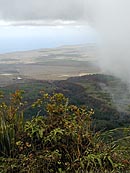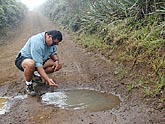By Timothy Hurley
Advertiser Maui County Bureau
LANA‘I CITY, Lana‘i — As mountains go, Lana‘ihale is no Mauna Kea or Haleakala, but it is the only mountain this island has, and its importance to the 2,700 people who live here cannot be understated: Under its forested slopes lies the island’s only aquifer, the sole source of drinking water.
| Axis deer
 Height: 30-36 inches at the shoulder. Height: 30-36 inches at the shoulder.
 Weight: Weight:
 Range: Lowland semi-desert kiawe and koahaole forests to higher-elevation fern and rain forests on Lana‘i, Moloka‘i and Maui. Range: Lowland semi-desert kiawe and koahaole forests to higher-elevation fern and rain forests on Lana‘i, Moloka‘i and Maui.
 Origin: Brought to Hawai‘i in 1868 as gift to Kamehameha V from the Hawaiian consul in Hong Kong. Origin: Brought to Hawai‘i in 1868 as gift to Kamehameha V from the Hawaiian consul in Hong Kong.
|
But for more than a century "The Hale," as residents call it, has been under attack. First, sheep and goats mowed their way across the mountainside, turning whole sections into eroded gullies and lifeless hardpan. Now, the island’s ubiquitous axis deer continue the onslaught.
Recent drought has worsened the damage, leaving much of the watershed crippled in its ability to capture water from passing clouds.
Today, however, the island is poised to fight back. Lana‘i’s major landowner, Castle & Cooke Resorts, in partnership with several government agencies, plans to construct a fence to lock out the deer from a 3,580-acre region surrounding the summit.
The ambitious 10-year program calls for fencing off the region in three sections, followed by public hunts to rid each area of deer. Then native plants and thousands of trees will be planted in an effort to rebuild the forest.
"This is vital to the island," says Darrell Stokes, conservation manager for Castle & Cooke Resorts. "Without the forest, there is no water. It’s not a matter of ‘Should we do this?’ We have to do this."
Lana‘i-reared Robert Hobdy, the 58-year-old Maui District manager with the state Division of Forestry and Wildlife, says Lana‘ihale has lost 50 percent of its native forest since he was a child. Without this fence, he says, the mountain’s native forest is doomed.
Initial skepticism
Several public meetings were held over the past couple of years to inform the community about the project. At first, Stokes says, there were skeptics, especially among those who won’t be able to hunt in the summit region anymore. But attitudes turned after they learned about its importance to the island’s water, he says.
 |
| Fog drip from clouds on Lana‘i’s peak is estimated to produce 50 percent of the water in the island’s aquifer. Deer increasingly threaten the watershed terrain.
Tim Hurley • The Honolulu Advertiser |
Ron McOmber, an avid hunter and longtime critic of Castle & Cooke, doesn’t quite see it that way. He says most of the island’s hunters didn’t attend the meetings and remain oblivious.
"When they put the fence up, all hell’s going to break loose," McOmber says.
But hunter Jason Fujie says he thinks most hunters do understand the need to protect the watershed and will sacrifice for the good of Lana‘i. There would still be 30,000 acres of public hunting grounds on Lana‘i and another 30,000 acres of private hunting areas.
McOmber, a member of the Lana‘i Water Working Group, says he’ll sorely miss hunting at the summit, but the reforestation project is indeed critical. However, McOmber is skeptical of Castle & Cooke’s commitment to the project and doubts that the company will throw enough resources behind it to finish the project.
Fencing alone is expensive. The project calls for nearly 20 miles of 8-foot-high steel-and-wooden fencing with mesh small enough to prevent even the youngest of deer from squeezing through. The cost will approach $1 million.
Grants provide a start
Stokes acknowledges that the company doesn’t have all the financing in place to see the project through. But, he says, federal and state grants have been secured to get started. Among the grants is a 10-year $750,000 state Forest Stewardship Program that must be matched by Castle & Cooke.
Protecting the watershed is essential, says Stokes, because Lana‘i doesn’t have as much drinking water as the other major Hawaiian islands. Lana‘i is in the shadow of its large neighbor, Maui, and Lana‘ihale’s 3,370-foot summit — Lana‘i’s wettest spot — receives only 30 to 35 inches of rain a year.
Yet state reports note that the vegetation and soils are more typical of a forest receiving 60 inches or more of rain per year. The reason for this anomaly is something called "fog drip."
"Fog drip is what saves us," Stokes says.
It occurs when clouds pass through the mountaintop forest and trees and ferns rake the moisture from the fog. There are estimates that fog drip accounts for 50 percent of water levels in Lana‘i’s aquifer, and puddles of fog drip can be seen in the summit region.
A study of one large tree near the summit found it capable of producing 250 gallons of water an hour in the thickest fog.
"If you stand under a Cook pine, it just rains down. It’s incredible," says Bryan Plunkett, a Castle & Cooke conservation worker.
 |
| Darrell Stokes, Castle & Cooke Resorts conservation manager, examines a fog-drip puddle near the summit of Lana‘ihale. A proposal to fence off the watershed is intended to protect against damage by deer.
Tim Hurley • The Honolulu Advertiser |
About 100 years ago, George C. Munro, the legendary Lana‘i ranch manager, planted the Lana‘ihale highlands with tall Cook Island pines and other trees to draw water from the passing clouds. Munro also planted seeds and clippings from his native New Zealand in an effort to perpetuate the watershed.
"What we’re doing today is just extending what he did," says Saul Kahihikolo, programs coordinator for Castle & Cooke’s conservation department.
Munro also attempted to erect a cattle fence around the summit, and its remains still exist. A portion of it is visible along the Munro Trail, the hiking and jeep trail that runs along the mountain’s 6-mile-long spine.
The proposed fence project would not impede recreational access to the Munro Trail and other summit areas.
In addition to preserving the aquifer recharge area, the fence project will help preserve rare and endangered native plants, which have been proven to be the best watershed plants.
About 70 native plants traditionally found on Lana‘i have disappeared, while an additional 64 are either listed as endangered or threatened, according to Stokes.
Of eight species of forest birds once native to Lana‘i, only one remains.
The native species barely had a chance after goats and sheep were introduced to the island in large numbers in the 1860s. Cattle were introduced in 1911, and axis deer followed in 1920.
Up to 10,000 deer
While the goats, sheep and cattle have been eliminated from the mountain landscape, the deer have thrived, especially in the upper forest where they dine on saplings, rub away bark on older trees and graze on grass and shrubs that help hold the soil.
In their native forests of India, axis deer are kept in check by tigers. On Lana‘i, they are kept in check by hunting, and the number of deer ranges from 6,000 to 10,000.
Fencing, though controversial for its limitation on hunters, is an increasingly popular tool for protecting watersheds. In Hawai‘i, there are a growing number of sensitive areas being surrounded by fences.
"It’s amazing what a fence will do for nature," says Karl Dalla Rosa, a forester with the state Division of Forestry and Wildlife.
The results have been dramatic in a five-acre mountain enclosure recently constructed at ‘Awehi on Lana‘i, where ‘a‘ali‘i, pukiawe, ‘ohi‘a and extremely rare na‘u, a native gardenia, are thriving.
For Stokes, conservation manager since 1999, this project is his passion. It is his crusade.
"This is more than a job," he says. "A job is something you have to do. This is something I want to do. Personally, this is something that fulfills my soul. It’s giving back to the ‘aina and it’s doing something right with my life.
"I’m going to spend the rest of my career trying to expand this forest."
[back to top] |



